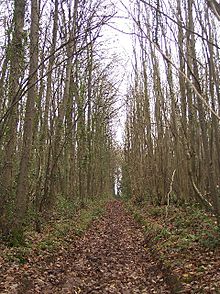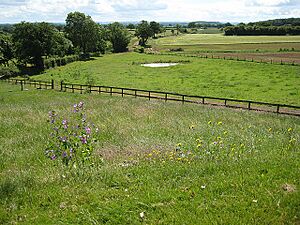Collinpark Wood SSSI facts for kids
| Site of Special Scientific Interest | |

Collinpark Wood - old route way
|
|
| Area of Search | Gloucestershire |
|---|---|
| Coordinates | 51°56′55″N 2°21′52″W / 51.948579°N 2.364418°W |
| Interest | Biological |
| Area | 66.69 hectare |
| Notification | 1966 |
Collinpark Wood is a special natural area in Gloucestershire, England. It's a protected place called a Site of Special Scientific Interest (SSSI). This means it's important for its unique plants and animals.
The wood covers about 66.69 hectares, which is like 165 football fields! It was first recognized as an SSSI in 1966. Part of the wood, about 15 hectares, is owned and looked after by the Gloucestershire Wildlife Trust. They bought this section in 1979 with help from the WWF.
Collinpark Wood is an ancient woodland, meaning it has been a forest for a very long time. For hundreds of years, people managed the wood by cutting trees in a special way called "coppicing." Until the 1850s, the wood provided timber to make charcoal for the iron industry. You can still see straight paths in the wood that might have been old tramways, used for moving materials.
Along one side of the wood, there's a cutting and a raised bank. These are signs of a railway line that was never finished! It was meant to connect Worcester and the Forest of Dean coalfields. The wood grows on special rocks called Triassic Keuper Marl. These rocks make the soil a bit acidic, which affects the types of plants and animals that live here.
Contents
A Look at Collinpark Wood's Past
The history of Collinpark Wood is quite interesting. For many centuries, until the 1540s, the Pauntley Estate, which included Collinpark Wood, belonged to the Whittington family. It's believed that Richard (Dick) Whittington, who became a famous mayor of London, might have been born nearby. He probably played and hunted in this very wood when it was known as Pauntley Wood.
In the 1540s, the land went to the Somerset family. A map from 1577 shows that the wood had been turned into a deer park. This was a popular thing to do back then, creating a special area for hunting deer. The name Collinpark started to be used around this time.
Later, in 1821, a Member of Parliament named David Ricardo bought Pauntley. His son, Osman, invested in a railway company that wanted to build a line through the wood. But the company failed, and the railway was never completed. In the areas where the railway was supposed to go, new trees like sweet chestnut were planted. This part of the wood is now called secondary woodland because it grew back after being disturbed.
Trees of the Woodland Canopy
The main trees that form the top layer, or "canopy," of Collinpark Wood are small-leaved lime and sessile oak. This wood is also home to many wild service-trees, more than almost anywhere else in Gloucestershire.
Other trees you can find here include wild cherry, ash, field maple, silver birch, pedunculate oak, and aspen. Below the main canopy, you'll find smaller trees and shrubs like hazel, broom, goat willow, and guelder-rose.
Plants on the Forest Floor
The plants growing on the ground in Collinpark Wood are quite special. Some, like common cow-wheat, great woodrush, wavy hair-grass, foxglove, and slender St John's wort, prefer the acidic soil found here.
You'll also see more common woodland plants such as bluebell, yellow archangel, wood sage, and wood-sorrel. The damp, rich environment also allows many different types of mosses, liverworts, and fungi to grow and thrive.
Birds and Other Animals
Collinpark Wood is a great place for birdwatching! You might spot birds like the willow warbler, chiff-chaff, blackcap, and the great spotted woodpecker.
The wood is also home to many small creatures. Some types of snails, flies, and beetles found here are special because they only live in very old woodlands. This helps scientists know that Collinpark Wood is truly an ancient forest. To help protect bats, there are also special bat boxes set up in the wood.
Protecting Collinpark Wood
People work hard to protect Collinpark Wood. In some areas of the nature reserve, they use "coppicing" to create open spaces called "butterfly glades." These sunny spots are perfect for butterflies to feed and lay their eggs.
The taller trees are also managed to be a future source of timber. Other areas of the wood are left untouched. This allows experts to compare them with the managed areas and learn the best ways to look after the entire wood for the future.



